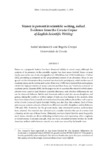Mostrar o rexistro simple do ítem
Stance is present in scientific writing, indeed. Evidence from the Coruña Corpus of English Scientific Writing
| dc.contributor.author | Moskowich, Isabel | |
| dc.contributor.author | Crespo, Begoña | |
| dc.date.accessioned | 2016-05-19T15:21:15Z | |
| dc.date.available | 2016-05-19T15:21:15Z | |
| dc.date.issued | 2014 | |
| dc.identifier.citation | Moskowich, Isabel y Crespo, Begoña. Stance is present in scientific writing, indeed. Evidence from the Coruña Corpus of English Scientific Writing. Token: A Journal of English Linguistics 3, 2014: p. 91-114 | es_ES |
| dc.identifier.issn | 2299-5900 | |
| dc.identifier.uri | http://hdl.handle.net/2183/16692 | |
| dc.description.abstract | [Abstract]Stance as a pragmatic feature has been discussed widely in recent years, although the analysis of its presence in the scientific register has been more limited. Stance is most clearly seen in the use of adverbs (Quirk et al. 1985; Biber et al. 1999; Huddleston – Pullum 2002), providing a comment on the propositional content of an utterance. Thus, in any speech act the information they transmit involves both participants, which in the case of academic prose are the writer and reader. Biber et al. (1999) have claimed that oral registers exhibit the highest number of stance adverbs and that these are “relatively common” in academic prose (Tseronis 2009). In this paper we try to ascertain the extent to which stance adverbs were used in Late Modern scientific discourse, and whether differences in use can be observed between British and American authors and also across disciplines and genres, taking the orality or written nature of texts as a key feature in the analysis. Data have been drawn from around one hundred and twenty authors, from three sub-corpora of the Coruña Corpus of English Scientific Writing (see also Zea, this volume). Each of these sub-corpora contains extracts of texts from different scientific disciplines written between 1700 and 1900. However, for the present study, only nineteenth-century authors have been selected. The material also allowed us to consider whether the sex of a writer had a bearing on the use of these forms. Ultimately, we have found that the most frequently used stance adverbs are those indicating inclusiveness and expressing either emphasis or tentativeness. Curiously enough, they are more abundant in texts written by North American authors and when we come to sex, male uses exceed by far female ones. | es_ES |
| dc.description.sponsorship | Ministerio de Economía y Competitividad;FFI2013-42215-P | es_ES |
| dc.language.iso | eng | es_ES |
| dc.publisher | Jan Kochanowski University Press | es_ES |
| dc.subject | Scientific register | es_ES |
| dc.subject | Academic prose | es_ES |
| dc.subject | Stance adverbs | es_ES |
| dc.subject | English scientific writing | es_ES |
| dc.subject | Corpora | es_ES |
| dc.title | Stance is present in scientific writing, indeed. Evidence from the Coruña Corpus of English Scientific Writing | es_ES |
| dc.type | info:eu-repo/semantics/article | es_ES |
| dc.rights.access | info:eu-repo/semantics/openAccess | es_ES |
| UDC.journalTitle | Token: A Journal of English Linguistics | es_ES |
| UDC.volume | 3 | es_ES |
| UDC.issue | 2014 | es_ES |
| UDC.startPage | 91 | es_ES |
| UDC.endPage | 114 | es_ES |
Ficheiros no ítem
Este ítem aparece na(s) seguinte(s) colección(s)
-
GI-MUSTE - Artigos [41]






